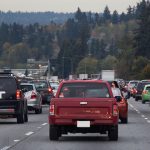Opinion: A tax I will gladly pay
I was so excited when I heard about the special election proposition that will appear on the ballot in November: Sound Transit 3, known as ST3. The Puget Sound Regional Transit Authority, who must first get public approval before undertaking any project, wants to expand the existing Seattle light rail by 62 miles. Currently, the light rail goes from the SeaTac airport to downtown Seattle. The group would like the rail to extend as far south as Tacoma and as far north as Everett.
This won’t be cheap, as one can imagine. The project will cost an estimated $54 billion, with half of this revenue raised through a 0.5 percent sales tax increase, a 0.8 percent motor vehicle excise tax increase, and a 25 cent property tax increase (per $1,000 of assessed value). These are not insignificant. Tacoma already has a sales tax of 9.6 percent and ST3 would raise it to over 10 percent. The MVET would cost about 80 additional dollars per $10,000 in vehicle value. My husband and I aren’t property owners, but the additional $48 my landowners will pay on our house may very well be tacked onto our monthly rent.
However, these costs will easily be offset if the new public transportation options are utilized. Think of all the gas you would save if you never had to commute by car as long as you were traveling between Tacoma and Everett. Think of all the time and money you would save not looking or paying for parking. Think of the reduced risk of accidents that might raise your car insurance premium.
The benefits of an expanded light rail system go beyond financial incentives. The thought of a torturous morning commute to Seattle has surely scared away job applicants from certain areas. And the prospect of moving to Seattle is no less bewildering, considering the skyrocketing housing market. An increase in transportation infrastructure would allow the already thriving Seattle economy to continue to thrive while not forcing its workers to live in the area.
Recreationally, going to sporting events such as Mariners, Seahawks, and Sounders games would be cheaper and easier. How fun would it be to ride to the game with fellow Seahawks fans and then to ride back excitedly after a big win? Additionally, there are many parades, festivals and concerts in Seattle that I would consider going to if I knew it would be a breeze getting there and back.
And then, of course, there are the environmental benefits. There will be less cars on the road and less traffic congestion for the ones that remain. The longer cars sit in traffic and idle, the more carbon dioxide they dump into the atmosphere. Less cars on the road reduces oil on pavement, decreasing the amount that ends up in our water bodies through stormwater runoff. Additionally, the less we drive our cars, the less we need to replace our tires, reducing the amount of rubber waste we produce.
The proposal has many corporate backers. Microsoft wants to be able to transport its employees to its massive Redmond headquarters while allowing them the freedom to live further away. Other backers include Amazon, Expedia and Vulcan Aerospace, all of which have corporate headquarters in Seattle and are likely hoping the increase in transportation options will help with recruitment. Other backers, such as the Washington and Northern Idaho District Council of Laborers and the International Union of Operating Engineers, are looking forward to the decades of jobs this project would create.
Before I saw any commercials in favor of ST3, I saw multiple lawn signs in the Lakewood Towne Center against it. The signs were simple: “No on Prop 1. Fund schools first.” Would funding light-rail expansion come at the expense of local schools? I decided to look into it further.
But there was nothing more to look at.
The official website of the People for Smarter Transit mentions that the proposal would come at the cost of schools but offers no further explanation. A more compelling argument the website makes is Sound Transit’s admittance that extension of the light rail would add only 32,000 new riders, which would be less than 1 percent of all trips in 2040. But once again, these numbers are not explained further anywhere else. In fact, the entire website only includes one informative link and it’s to a Seattle Times article that mentions neither schools nor 1 percent of trips, but instead calls for an extension of time to discuss the proposal before it is voted on. This lack of a detailed counterargument is quite baffling, considering the tax increases are so significant.
Alternatively, an opposing website run by “concerned voters and taxpayers” is much more detailed — albeit crudely put together. Their site contains links to an independent e-zine — Public Interest Transportation Forum — that has tracked and discussed public transportation and mobility issues in the region since 1996. While the website has a handful of dead links and outdated news articles, the e-zine is impressive and is clearly run by people who care passionately about public transit. (As of this writing, the website mentioned here is no longer live.)
When it comes down to it, these taxes would apply to me and I would be willing to pay them. I would use the light rail constantly. I already use the Sounder, Link, bus and Seattle light rail whenever possible. This new extension would virtually eliminate my need to drive altogether. This is a burden I’d be willing to bare.






